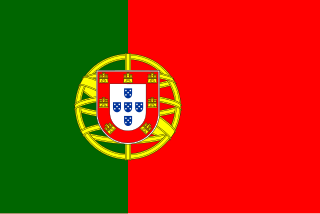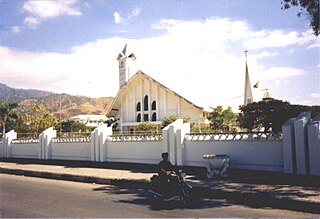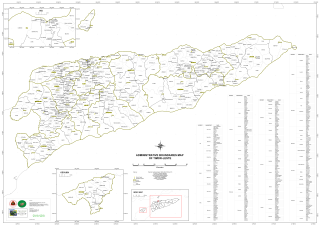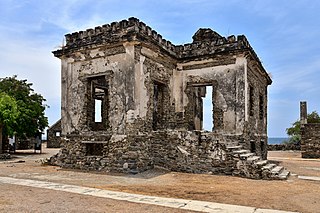
Portuguese Timor was a colonial possession of Portugal that existed between 1702 and 1975. During most of this period, Portugal shared the island of Timor with the Dutch East Indies.

Dili is the capital and largest city of East Timor. It lies on the northern coast of the island of Timor, in a small area of flat land hemmed in by mountains. The climate is tropical, with distinct wet and dry seasons. The city has served as the economic hub and chief port of what is now East Timor since its designation as the capital of Portuguese Timor in 1769. It also serves as the capital of the Dili Municipality, which includes some rural subdivisions in addition to the urban ones that make up the city itself. Dili's growing population is relatively youthful, being mostly of working age. The local language is Tetum; however, residents include many internal migrants from other areas of the country.

Liquiçá is one of the municipalities of East Timor. Its capital is also called Liquiçá.

East Timor was a province of Indonesia between 1976 and 1999, during the Indonesian occupation of the country. Its territory corresponded to the previous Portuguese Timor and to the present-day independent country of East Timor.

Liquiçá is a coastal city in East Timor, 32 km to the west of Dili, the national capital. Liquiçá is the capital of Liquiçá District. The city has a population of 5,005 inhabitants.

Dili Municipality is one of the 14 municipalities, formerly districts, of Timor-Leste, and includes the national capital Dili. The municipality had a population of 277,279 as of 2015, most of whom live in the capital city.

Nelas is a municipality located in the Centro Region of continental Portugal. The population in 2011 was 14,037, in an area of 125.71 km².

The administrative posts of East Timor are subdivided into 442 sucos ("villages") and 2,336 aldeias ("communities"). Sucos have been a key to administration since the 20th century, under Portuguese, Japanese, Indonesian, and independnet rule.
Alas (East Timor) is a town in Alas Subdistrict. It is located in the interior of the island, 294 metres above sea level. As the crow flies, Alas is 56 km southeast of the state capital Dili und 7 km to the East of Same. Alas lies to the North of the Suco of Mahaquidan (Malaquidan, Malagidan), and the Alas suburbs of Uma Mean (Umanican, Umamean) and Beremanek are located in Mahaquidan. The suburbs of Lurin und Ailora are in the suco of Taitudac (Taitudak, Taitudac, Taitudal). It is located in the interior of the island, 294 metres above sea level. As the crow flies, Alas is 56 km southeast of the state capital Dili und 7 km to the East of Same. Alas lies to the North of the Suco of Mahaquidan (Malaquidan, Malagidan), and the Alas suburbs of Uma Mean (Umanican, Umamean) and Beremanek are located in Mahaquidan. The suburbs of Lurin und Ailora are in the suco of Taitudac (Taitudak, Taitudac, Taitudal). There is a medical station and a helicopter in Alas, as well as a primary school (Escola primaria Alas Vila) and a pre-secondary school.

The Church of Santo António de Motael is the oldest Roman Catholic church in East Timor and is located in Dili, the country's capital city. It is dedicated to Anthony of Padua. While the first church at this location was built around 1800, the current building dates back to 1955.

The Palácio de Lahane, also known as the Palácio das Nobres, is a historic building in East Timor. As of 2022, its primary function was as a reception space for the East Timorese government.

Maubara, officially Maubara Administrative Post, is an administrative post in Liquiçá municipality, East Timor, just west of the city of Liquiçá. Its seat or administrative centre is Vaviquinia.

Dili became the capital of the Portuguese colonial possessions in the Lesser Sunda Islands in 1769. Today, Dili is the capital of East Timor.

The Dili Harbor Lighthouse ) is a lighthouse on the shore of the Bay of Dili next to the beach on the west side of Dili, capital city of East Timor. It assists with navigation into and out of the Port of Dili.

Casa Europa is an historic late nineteenth-century Portuguese colonial building in the Bidau Lecidere suco of Dili, capital city of East Timor.

Ai Pelo Prison or Aipelo Prison is an historic late nineteenth-century Portuguese colonial prison in the Lauhata suco, East Timor, adjacent to the Savu Sea. It was deactivated in 1939 and is now a ruin.

The Banco Nacional Ultramarino (BNU) building, in the centre of Dili, capital city of East Timor, is a modernist structure unusual in Timor. Constructed between 1966 and 1968, it has only one contemporary, the ACAIT building, formerly the headquarters of the now defunct Timor Commercial, Agricultural and Industrial Association.

The Liceu Dr. Francisco Machado is a neoclassical / Portuguese colonial former school building in the Colmera suco of Dili, capital city of East Timor. It is located one block west of the National Parliament of East Timor, and faces Rua de Moçambique. Today, it houses the Faculty of Education, Arts and Humanities of the National University of East Timor.

The old Municipal Market of Dili, now the Dili Convention Centre, is a renovated and repurposed historic Portuguese colonial-style former public market building in Dili, the capital city of East Timor.
Fatuhada is a Suco ("village") in East Timor under the Administrative Post Dom Aleixo Administrative Post in Dili Municipality, within the capital city Dili.

























